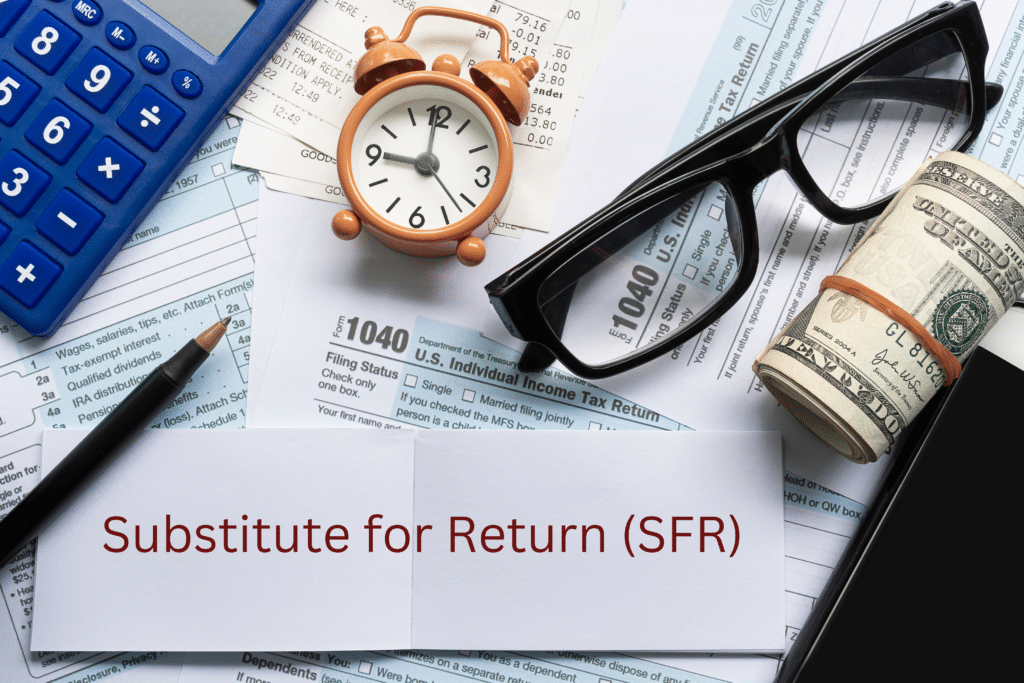IRS Substitute for Return: Reasons Why Unfiled Taxes Are Disastrous

Filing taxes is a responsibility that none of us can escape, yet thousands of taxpayers find themselves in a difficult situation every year. They fail to file their tax returns, and when that happens, the IRS steps in with a Substitute For Return (SFR). It allows the IRS to prepare a tax return on behalf of those who failed to fulfill their annual filing obligations.
This guide will explain how the IRS Substitute for Return works, its consequences, and tips to address it.
What is a Substitute For Return (SFR)?
The IRS generates a Substitute for Return when you fail to file your tax return. This return is often based on available information, such as W-2 or 1099 information reported by your employer. However, it will not take into account any tax credits or deductions you might be eligible for. It uses the filing status of single or married filing separately and applies only the standard deduction.
The agency files a substitute return primarily to protect the government’s interests and ensure they collect the taxes they believe you owe. However, this can often result in you paying more in taxes than you should.
How the IRS Files a Substitute for Return
1. IRS sends out notices
The process begins when the IRS becomes aware that you may have a filing obligation, but they have no record of your return in their system. At this stage, the IRS sends out several notices as a request for you to address your filing obligations.
2. IRS files a substitute for return
If you ignore the initial notices and requests, and your return remains unfiled for more than 12 months, the IRS can proceed with filing a substitute return on your behalf. The agency will use third-party income information, such as W-2s and 1099s, to create the SFR. As previously mentioned, deductions, exemptions, and other tax benefits are not considered in this process. As a result, it may overstate your tax liability.
3. The agency issues a CP2556 notice
Once the IRS has prepared the substitute return, they will send you a CP2566 notice. This letter informs you of the IRS’s actions, including the computation of your taxes and the associated penalties and interest. Upon receiving the notice, you have a 30-day window to take action. During this period, you have three options:
- File a tax return for the indicated year(s).
- Contact the IRS and explain why you believe you don’t need to file.
- Sign and date the Consent to Assessment and Collection form provided by the IRS and return it to them.
4. You receive a Notice of Deficiency
If there’s still no response within the 30-day window, the IRS takes a more serious step. They will issue you a Notice of Deficiency or a 90-day letter, which will serve as your final warning. This notice arrives via certified mail and carries a stronger tone. Upon receiving the notice, you will enter a 90-day challenge period. During this time, you have several options:
- Agree with the IRS’s calculations and assessments on the substitute return.
- File your return for the tax year(s) mentioned in the notice
- Write a letter explaining why you believe you are not required to file
- Challenge the IRS determination in the U.S. Tax Court
The Danger of Ignoring the 90-Day Notice
If you fail to address the issue within the given time frame, the IRS can proceed with collection actions, which may include tax liens, levies, and wage garnishment. These actions are taken to settle the outstanding tax debt.
Why It’s Important To File Correct Returns?
Filing your tax returns allows you to claim deductions, credits, and exemptions you’re entitled to. The substitute return filed by the IRS doesn’t consider these factors, which leads to a higher tax liability.
For example, if you’re a self-employed contractor, and the IRS generates an SFR based solely on the income reported through 1099s. The SFR doesn’t account for the subcontractor labor costs or materials and supplies expenses, which can significantly reduce your tax liability when you file your own return.
Best Way To Handle a Substitute For Return
Timely action is your best ally when dealing with an IRS Substitute for return. When you get a notice about your tax obligations, don’t delay. Consider filing your own tax return to make sure you claim all the tax benefits you’re entitled to and lower how much you owe.
If you’re unsure or need assistance in handling a substitute return, call us at 775-245-4357. Our team of experienced professionals is ready to help you navigate the complex world of taxes and find the best solutions for your unique situation.
